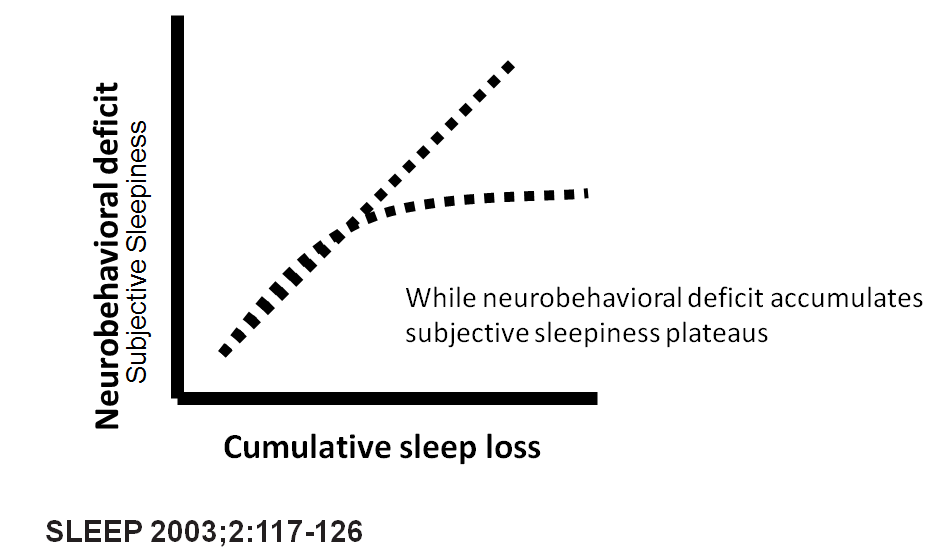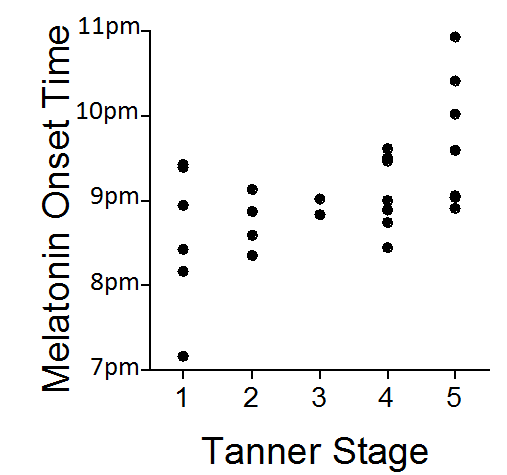The Biologic Causes of Teen Car Crashes Due to Insufficient Sleep
Insufficient sleep increases the risk for car crashes due to four biologic contributors: the plateauing of perception, hormonal changes delay the biologic clock, lack of driving experience, and poor appraisal of risk caused by an immature prefrontal cortex.
1. While the real-life consequences of sleep debt accumulate continually, the brain’s ability to perceive disability plateaus.1 (See figure 1.) Many have expressed this saying, “I can’t feel more sleepy, my brain is tapped-out”. Insufficient sleep leads to cognitive errors. These include errors of commission and errors of omission. An error of commission occurs when a sleepy driver does more than is necessary; for example, over-braking or over-steering causing a car to flip over. A classic error of omission is the night-shift health-care worker who drives through a red light at which they would otherwise routinely stop “without thinking”. This inability to easily do routine things should be a red flag that something is amiss. Unfortunately, sleep deprivation not only impairs motor abilities, it impairs even the ability to perceive there is a disability. Lack of perception piles upon the deficiencies until a tragedy occurs: the car crash.
Figure 1

We all share the difficulties described above as a consequence of being human. Teens suffer additional difficulties. The hormones of puberty delay the biologic clock.2 (See figure 2 below.) When the delayed sleep phase of a teen meets a high school start time that is too early (before 8:30 a.m.) the result is chronic, accumulating insufficient sleep.
Figure 2

Physical changes of puberty are referred to as the 5 Tanner stages starting at prepubescence (Stage 1) and leading to sexual maturity (Stage 5). This study revealed the release of melatonin, the hormone aiding in sleep, is later with each Tanner stage. Later melatonin release correlates with a later biologic bedtime.
In addition to the biologic risks above, teens are at particular risk for car accidents because of their inexperience. Furthermore, the immaturity of the teen prefrontal cortex inhibits the ability to appreciate long term future risk. Sleep disruption conspires to make teen’s poor judgement of risk even worse.
It is no wonder parents lose sleep worrying about their teen who has just begun to drive independently. Teens face a quadruple diving threat: inexperience, underestimation of risk, a biologic clock predisposed to delayed sleep phase, and plateauing of risk perception despite the ongoing accumulation of deficiencies. As a result, early school start times can play a role in teen crash rates. In two adjacent counties in Virginia, the school with the earlier start time had significantly higher crash rates. Crashes increased in both the drive to and from school, reflecting the impact of the sleep deficit in cognitive function. This counters the common misconception that once the morning lethargy is overcome, teens will be just fine (3). In another study, sleep duration and timing was assessed before and after the school adjusted their start time by one hour later. Significant decreases in car crashes were noted, even despite a rapid increase in population growth within the community. (4)
References:
- Van Dongen HP, Maislin G, Mullington JM, Dinges DF . The Cumulative Cost of Additional Wakefulness: Dose-Response Effects on Neurobehavioral Functions and Sleep Physiology From Chronic Sleep Restriction and Total Sleep Deprivation. Sleep 2;117-126
- Carskadon MA, Acebo C, Jenni OG. Regulation of adolescent sleep: implications for behavior. Ann NY Acad Scki. 2004;1021:276-291.
- R Vorona, et al. Adolescent Crash Rates and School Start times in Central Virginia Counties 2009-2011. Journal of Clinical Sleep Medicine. Vol 10 , no 11, 2014.
- F Danner, B Phillips. Adolescent Sleep, School Start Times and Teen Motor Vehicle Crashes. Journal of Clinical Sleep Medicine. 4(6) 2008
